842 Search Results for core vocabulary
November 23, 2013
by Carole Zangari -
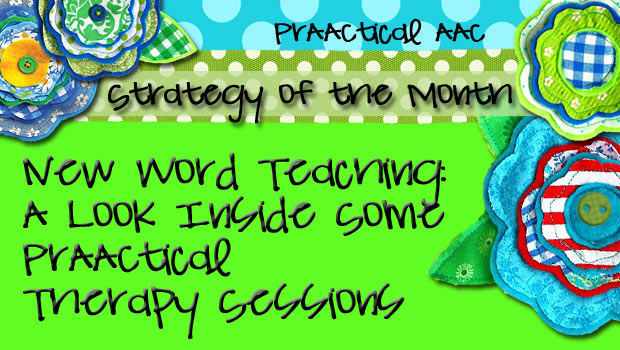
Since we’ve been talking about vocabulary instruction, we thought it might be fun to take a peek inside some therapy sessions where new words were being taught. In the examples below, we were teaching a core word and a Tier 2 vocabulary word over a few sessions. Here are some excerpts with their key intervention principles and practices. Target Words: do/did as an auxiliary (not main) verb Activities: Introduced a Visual Support (anchor chart): This explained the concept of ‘Helping Verbs,’ provided information on how they are used, listed them, and provided examples. These are effective tools for initial teaching, but are also invaluable for ongoing instruction. We use them extensively in language therapy, referring back to them often when we want to reinforce correct responses (look back at the visual together to further solidify the concept), help ‘fix’ incorrect responses (reteaching the pieces that didn’t stick), and facilitate self-correction... [Read More...]
November 1, 2013
by Robin Parker -
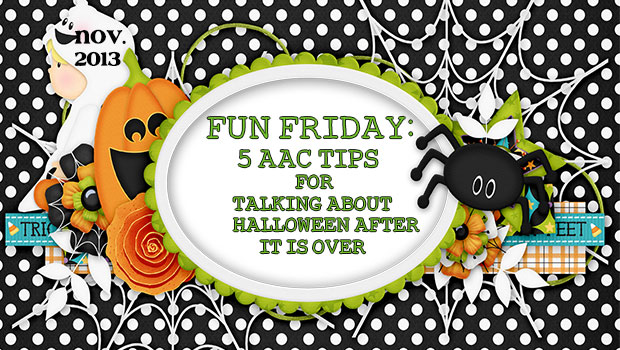
Language learning involves talking about events in the past, present, and future. Since Halloween is over, it is a perfect opportunity to help AAC users talk about past events. Here are 5 tips for getting started with ALL learners. Use a weekly or monthly (calendar) schedule to ‘remember’ Halloween or if you are sticking to core words to remember the “great day” or “bad day” depending upon the experience. Use photos of the Halloween festivities to discuss what happened, what everyone did, and you could even go for the best and/or worst part of the day. Use a Venn diagram to compare and contrast Halloween experiences. This can be done with comparing 2 people or 2 groups. For some learners, you can use images to put Halloween things that everyone saw or did while others you will need text only. Then, a discussion of what each student/group did that... [Read More...]
October 26, 2013
by Robin Parker -
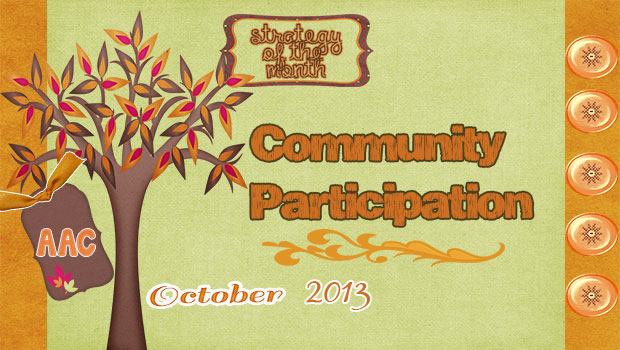
Community participation and communication for AAC users is an integral part of of developing, growing up, and having inclusive opportunities. We often relate community participation to quality of life indicators. Community participation for AAC users begins from the… beginning. Young children can order in restaurants, use picture menus, and have access to many inclusive events. As children grow into adolescents and adults, community participation involves post secondary options, employment, and community living. Perspectives from AAC Users Have communication displays and devices available at ALL times– You need access to a communication system(s) to participate in all situations. Remember to take AAC with you. The sooner the AAC user becomes responsible for taking or telling someone to take the device/displays with them the easier it becomes. For mobile technology systems, there are rugged cases that withstand wind, water, even medical waste (see Lauren Enders Pinterest boards for case and accessory options).... [Read More...]
October 24, 2013
by Robin Parker -

Cooking is a great activity as the platform for meaningful language experiences for both children and adults. Halloween often involves candy and tasty treats. However, there are also plenty of healthy Halloween foods (e.g., carrot pumpkins, tangerine & celery pumpkins, or apple teeth to name just a few). Then comes Thanksgiving and all the recipes that go along with it (e.g., lots of opportunity for repetition with variety). Everyone can be involved with cooking, although just because you cook doesn’t mean you need a stove. From spooky chex mix to more elaborate cookie and cake decorations, there is a ton of active participation and conversation that can be incorporated into cooking. And the fun and rewards (eating) are built-in. Although there are plenty of Halloween recipes, many recipes can be turned ‘spooky’ with an addition/modification of Halloween shapes or colors. You can cook using core words and/or focusing on the... [Read More...]
October 22, 2013
by Carole Zangari -
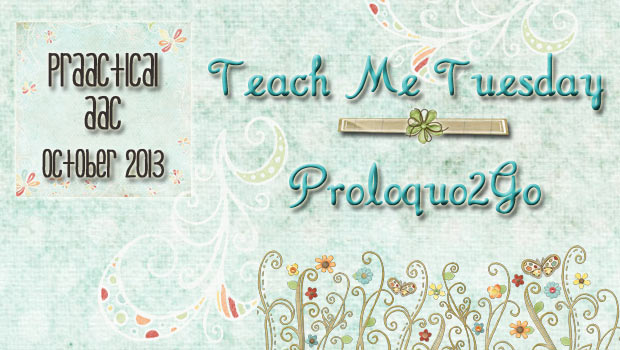
This week in Teach Me Tuesday we’re learning more about Proloquo2Go (P2G) by AssistiveWare. Here are the learning resources we’ll be using. Getting Started Webinars (on the right) Overview/Intro to P2G 3 Core Word Vocabulary-How to Customize It and Basic Communication Vocabulary: How to Customize It P2G Options, Part 1 and Part 2 Buttons, Clues, & Resources Making Back Ups and Saving: Save, Transfer & Restore a Backup Using iTunes for Windows Save, Transfer & Restore a Backup Using iTunes for Mac OS X Save, Transfer & Restore a Backup Using Dropbox Save, Transfer & Restore a Backup Using Using WiFi Getting Help within the P2G App Beyond the Basics Advanced Customization VocaPriority: Prioritize Vocabulary by How Frequently It Gets Used For those who Used the Original P2G Upgrading to P2G 2 Moving from the Old Vocabulary to the New Ones Discussion board/forum by AssistiveWare Manuals and documents by AssistiveWare Connect with AssistiveWare... [Read More...]
October 4, 2013
by Robin Parker -
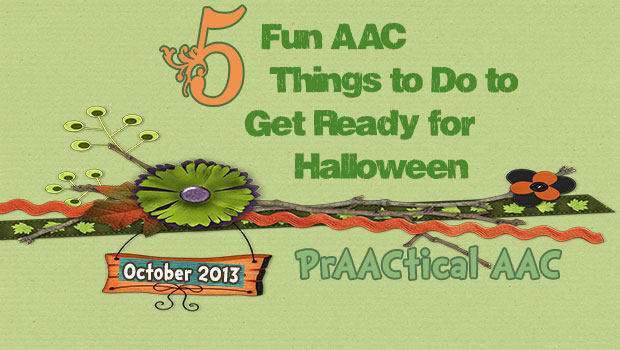
We love to start planning for holidays early. It helps facilitate conversation before, during, & after exciting activities and events. When we begin using core and fringe vocabulary early, frequently, and authentically the learner has the most opportunity for success. Use Schedules: Use a monthly calendar to have a Halloween countdown, Use mini-schedules to make food recipes, spooky science concoctions, or even to plan the trick or treating routes. Use a small talk app like Fat Cat Spooky Chat to prAACtice what you will SAY (October core words) on Halloween. Use a social narrative to prepare everyone for what to expect on and around Halloween. More Halloween social narratives can be found at Autism Community, One Place for Special Needs, Katherine Sanger You Tube, & Kentucky Autism Training Center Prepare a choice board of Halloween costume options and let the learner decide on the costume. PrAACtice a script to be... [Read More...]
September 21, 2013
by Carole Zangari -
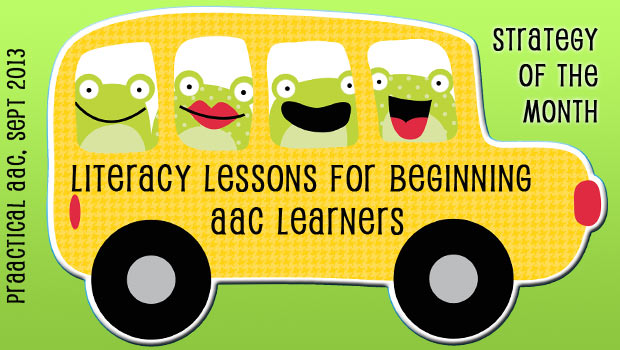
Like some of you, we are often met with skepticism when we encourage teams to work on literacy skills with individuals who are still learning the very basics of communication. Recently, we had the opportunity to begin this journey anew, and model a literacy lesson for kindergartners who have no formal communication system, are not answering yes/no questions, and do not consistently select preferred items when offered choices. Why work on literacy with students who are not routinely expressing their basic preferences? Because the longer we wait, the longer it will take to get there. Because it offers wonderful opportunities to build communication, too. Because when other people see us teaching reading and writing, it changes their perception of the student in a positive way. Because they will enjoy it. Because there are mandates for us to address the general education curriculum. Because if we set the bar high and... [Read More...]
September 11, 2013
by Robin Parker -
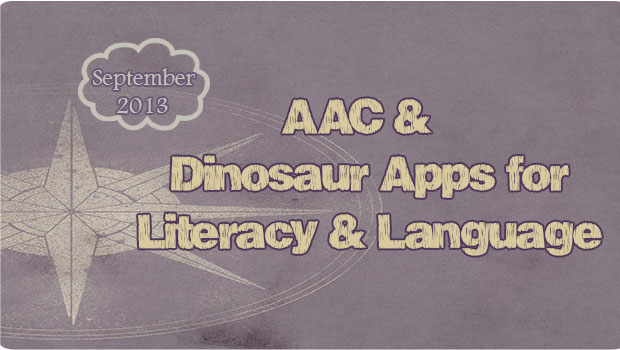
We have students of all ages who love dinosaurs. From young children to the teenager or adult we can use the theme of dinosaurs when teaching AAC, language and literacy. You can do a theme of fun dinosaurs all the way to paleontology and archeology. Dinosaurs as a theme can support goals for core & fringe vocabulary, narratives, reading, and writing. Many students will do more and work harder if there is a high interest theme. Here are some apps for those dinosaur loving students. Dinosaurs Books BooksHow to Hide A Dinosaur– children, iPad, fun book Dinoboy Adventures– children, iPad & iPhone +, interactive book where you can make choices to modify the story Tiny Time Machine- Dinosaurs– children, iPad & iPhone +, a travel adventure mystery Oh Can You Say Di -NO -Saur Dr. Seuss Cat In the Hat– children, iPad & iphone + , fun book Dinosaur Book HD: iDinobook–... [Read More...]
September 4, 2013
by Robin Parker -
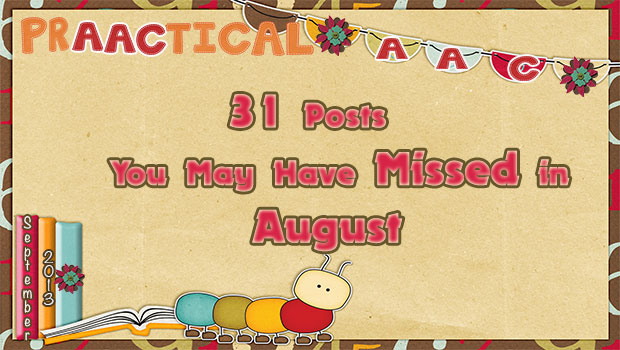
Strategy of the Month Back to School with AAC AAC ‘Must Haves’ for the Classroom & Speech Room PrAACtical Partnerships: AAC & Academics AAC Around the School and Beyond Core Words & the Curriculum PrAACtical Thinking 5 Things to Remember About AAC Technology Fun Friday Commenting to the Max 31 Posts You May Have Missed in July Keep Calm & …………. Great Music Apps & AAC Language Goals 5 Free Resources for Making Communication Boards & Visual Supports 5 Reasons to Say Yes to ‘NO’ Magic Moments with Tellagami Watch It Wednesday: AAC Core Word Vocabulary teaching by Gail Tatenhove & Robin 5 Ways to Use Sequenced Message SGDS and APPS 7 Writing Apps & Activities for ALL Writers PrAACtical Uses of QR Codes Watch This: Example of Teaching Expressive Language with the iPad & AAC Device by the Awesome AAC Chicks 5 Things to Consider About Data Collection in... [Read More...]
August 30, 2013
by Robin Parker -

by Carole Zangari, originally published on August 27, 2012 “How was school?” (Good) “What did you do?” (Nothing) This scenario plays out in many cars and kitchens in the after school hours and it can be hard to know who is more frustrated: the kids for being asked or the parents for not getting satisfactory answers. And still, we repeat the process day after day. Of course, we want to know the fine details of what happened and how our children felt, but in some cases, we’d settle for ANY school-related conversation at all. I’ll be the first to admit that it took me way too long to get the hang of how to get information about my children’s school days, and it seemed like just when I did, pow! They were pre-teens and then teenagers. New rule book. Here are some ‘lessons learned’ along the way about those afterschool conversations and... [Read More...]









